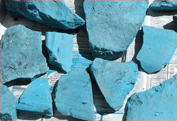
Between St William’s Church and George Street on the east side of Ince Green Lane there is a triangular plot of land called the Presbytery Garden. This is the site of one of our Society’s latest forays in the search of the elusive Roman Road from Manchester to Wigan. Prior to the start of proceedings Tom Glover presented the children of St. William's and Ince CE Primary Schools with certificates for participation in the work carried out in their school playing fields. The two test pits dug on the day produced quite an amount of datable pottery (1600-1750) and a very interesting collection of hand-made and obviously early bricks. In the first test pit these formed the lining of a stone covered drain found at a depth of about 60cm. It was 10cm deep and seemed to be clay lined along the bottom. All the early pottery was found laying on the drain slabs or on the same level in the very fine brown sub-soil. The very fine black garden soil provided the usual scatter of Victorian or Edwardian glass and pottery. The feature in the second test pit seemed to be a post hole which was surrounded by a circle of the bricks. This feature seemed to be at the end of this drain. However on further inspection it was thought that it could be a flue for a small kiln of some sort as the bricks show some discolouration due to heat. Judging from the pottery alone this a very interesting Post-Medieval site and deserves a revisit in the near future. Still no Roman road but the depth of the archaeology here is far more encouraging.
George Street
Last month work also started on sites either side of this cobbled road which was once lined with Victorian terraces. On the south side the foundations of the houses appeared to lie directly on top of a 5cm band of clay with no mortar to hold the brick together. The underlying geology here was pure sand to a depth 1.4m (with a band of natural pebbles/cobbles at 1m).  On the north side however the test pit produced mostly top soil, colliery spoil, ash, and rubble to a depth of 2m. The camber of the cobbles was severe nearby, as though sinking into an underlying hole or ditch (coinciding with the boundary shown on the 1849 map). On the north side however the test pit produced mostly top soil, colliery spoil, ash, and rubble to a depth of 2m. The camber of the cobbles was severe nearby, as though sinking into an underlying hole or ditch (coinciding with the boundary shown on the 1849 map).
Further Work
The intention is to do one more dig on this site (we have permission to remove the sets from the actual road surface) before moving on to the Ince CE Primary School site mentioned in last month’s newsletter. If you want to get involved please contact Brian Parr on 07704416021.
Synod of Whitby
In 664AD the Roman Catholic and Celtic Churches came together to sort out which versions of Christianity should be adopted by the emerging nation. And so it was that last month our Society’s disparate factions came together to try to thrash out a series of amendments to our constitution. One of the main bones of contention was the level of autonomy an excavation field team should be given to run projects independently of the main committee. It was generally agreed that more freedom would speed up proceedings, but conceding that overall control must remain with an elected committee. A set of proposals have been drafted and will be issued in the next week or so for your perusal. The intention is to have them debated and ratified at an EGM at the beginning of our May meeting.
Egyptology Day School
John Johnson’s Horus Society have organised this special event at the JJB for Saturday 5th July. Two of the worlds most prominent Egyptologists will be presenting their recent work on the mortuary temple of Amenhotep III (the Colossi of Memnon). This huge 2km square complex has already produced some remarkable finds. The cost for the day is £35 but this includes lunch at Rigoletto’s. If you are interested John will provide more detail at our next meeting.
Next Meeting
Wednesday 2nd April usual time usual place. This month Brian Marshell will be presenting his excellent talk on the Cathars of Southern France. These were an obscure Christian sect that rose to prominence in the Languedoc region in the 12th and 13th centuries. After a sustained campaign of terror and persecution, however, by the established Church they were eventually wiped out leaving only their castles to remind us of their existence. These events have been described by some as the greatest disaster ever to befall Christendom. Brian’s talks have always been well received and this one should prove no exception.
Hope to see you there B.A.
|



